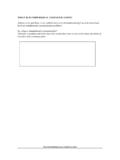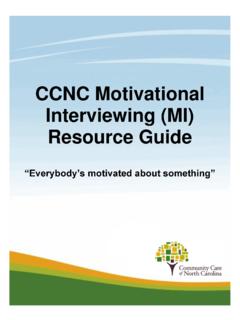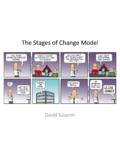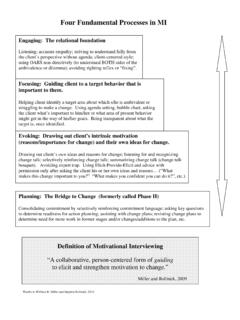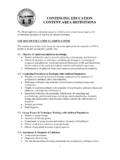Transcription of Motivational Interviewing: Steps to Success! - crnb …
1 Motivational interviewing : Steps to success ! step 1: Establish Rapport step 2: Assess Readiness step 3: Assess Motivation and Confidence step 4: Patient Identifies Problems and Solutions step 5: Identify Next Actions and Follow-up Create effective dialogue with your client step 1: Establish Rapport You may be a little fed up with people lecturing you about your smoking. I m not going to do that, but it would help me if I really understand how you feel about where smoking fits into your step 2: Assess Readiness (Stages of Change) Can you tell me what you think about cutting out smoking? step 3: Assess Conviction/Motivation and Confidence a) Conviction/Motivation Motivation: If, on a scale of 1 to 10, one (1) is not at all motivated to quit smoking and 10 is 100% motivated, what number would you give yourself at the moment?
2 Conviction: If you decided How would it benefit you? b) Confidence If you really decide do you think you could do it? If you were to decide to quit right now, how confident are you that you would succeed on a scale of 1 to 10? Can you give me an example of something you ve done in the past that worked well for you? Prepared by Cleo Cyr RN, BN, MHS ACSM Exercise Specialist & Wellness Coach April 2008 1 step 4: Patient Identifies Problems and Solutions a) Dealing with Conviction/Motivation If you decided to quit smoking, how would it benefit you? If you have used a motivation ruler ask: Why are you at 4 and not at 1? What would need to happen for you to get from 4 to 8? b) Identify Pros and Cons.
3 What do you like about smoking? What do you dislike about it? c) Summarize both sides; then ask Where does that leave you now? d) Nonjudgmental information about personal risk. What types of information have you heard about the risks of smoking? Ask permission to give expert information e) Dealing with Confidence Identifying Barriers: What would prevent you Identifying Strategies: How do you think you If you have used a confidence ruler ask: Why are you at 4 and not at 1? What would need to happen for you to get from 4 to 8? How can I help you get from 4 to 8? f) Brainstorm solutions. 1. Don t immediately offer a single simple solution 2. Encourage patient to say what could work (their past successes, experience of others, 3.
4 Wild speculation) 4. Supplement with your ideas 5. Patient chooses best option If no ideas come from patient, offer range of possibilities (but ask permission first) Prepared by Cleo Cyr RN, BN, MHS ACSM Exercise Specialist & Wellness Coach April 2008 2 step 5: Identify Next Actions and Follow-up Use Smart Goal Framework: Specific, Measurable, Action-oriented, Realistic, Time-limited Have the patient specify their intention: I will fill my prescription for Champix and quit smoking on Sunday May 11, 2008. I will journal how I feel every day for 5 days and call you on Friday May 16th at 1pm to talk about those feelings. If they are not ready to set a goal, keep communication open: Things do we agree to leave the door open on this one?
5 1. Develop a simple, specific plan for starting to change 2. Decide when, where and how the intention (goal) is to be implemented 3. Identify actions that can be taken soon (48 72 hours) 4. Follow-up to see if plan implemented. Communication 1. Understanding Irrationality Use Reflection You ve said that you overeat when you go family functions. Can you paint a picture for me of what happens to cause that? Listen to the person s story and assess: Seriousness Personal Responsibility Controllability if I m hearing you correctly you don t want to eat that much but Aunt Mildred s double chocolate cheesecake is simply irresistible & you don t want to hurt her feelings by not having some of it.
6 Ask open-ended How badly would you feel about hurting Aunt Mildred s feelings? Is that better or worse than how badly would you feel about not sticking to your goal of eating healthy? Prepared by Cleo Cyr RN, BN, MHS ACSM Exercise Specialist & Wellness Coach April 2008 32. Define and Support Self-Efficacy: Confidence in one s ability to perform a specific behaviour in specific contexts Use Rulers On a scale of 1 10 how confident are you that Aunt Mildred would be upset if you didn t eat her cheesecake? On a scale of 1- 10 knowing that you would feel worse about not sticking to your healthy eating plan, how confident are you that you wouldn t eat cheesecake? 3. Questions that can be used when going beyond the surface level Why do you want to change?
7 How hard are you willing to work to change? Are you willing to make choices that are hard in the short run even if positive in the long run? Components of Behaviour Modification for the Health Care Professional Behavioural Analysis: Self-monitoring Be very specific Good records can be kept for no more than 2 weeks Know why you are collecting data It not in the collecting but the analysis (lesson learned) Behaviour Shaping: Make it doable specificity and proximity Shape behaviour accept inadequate approximations Watch your expectations concerning Pace of change individuals are turtles not hares Number of behaviours on the table keep it under 3! Stimulus Control Identify the stimuli that elicit the unhealthy behaviour Take control of these stimuli, to whatever extent possible Specifically address availability Look for alternatives to the stimuli Identify barriers/temptations and make a plan Reinforcement management Prepared by Cleo Cyr RN, BN.
8 MHS ACSM Exercise Specialist & Wellness Coach April 2008 4 Identify positive reinforcements that can be administered by the individual contingent on specific behaviours Emotion Management Dealing with unhealthy coping strategies Recognition of value of unhealthy behaviour and willingness to change Stress Management Physical Discharge Physical Calming Emotional Expression Social Support Emotion Management Distress Depression Over the past 2 weeks, have you felt down, depressed or hopeless? Over the past 2 weeks have you felt little interest or pleasure in doing things? Focus on pleasure and mastery, behavioural activation, social support, problem solving, medication (SSRIs) Anxiety Increased risk of generalized anxiety Excessive worry Somatic preoccupation Exposure, self-talk, distraction Anger/Hostility Empathy training, relaxation, psychotherapy Prepared by Cleo Cyr RN, BN, MHS ACSM Exercise Specialist & Wellness Coach April 2008 5 Prepared by Cleo Cyr RN, BN, MHS ACSM Exercise Specialist & Wellness Coach April 2008 6 References & Additional 1.
9 The 10 Minute Motivator: Constructive conversations about smoking cessation in clinical practice by Dr. Robert Reid, Prevention and Rehabilitation Centre Univ. of Ottawa Heart Institute 2. Global Cardiovascular Risk Management: Patient Adherence Dr. Michael Vallis Psychologist, QEII Associate Professor, Dalhousie 3. 3 min empowerment: Improving Efficiency to Support behaviour Change. Pfizer Canada 4. Miller WR, Rollnick S. (2002) Motivational interviewing : Preparing People for Change, 2nd Ed. Guilford Press: New York. 5. Prochaska, J. O., & Velicer, (1997). The Transtheoretical Model of health behaviour change. American Journal of Health Promotion. 12: 38-48 6. Prochaska JO, DiClemente CC, Norcross JC.
10 (1992) In search of how people change. American Psychology. 47:1102-4. 7. Prochaska JO, Velicer WF, Rossi JS, Goldstein MG, Marcus BH, Rakowski W, et al. (1994) Stages of change and decisional balance for 12 problem behaviors. Health Psychology. 13:39-46. 8. Rollnick S., Miller WR, Butler CC. (2007) Motivational interviewing in Health Care: Helping Patients Change Behaviour. Guilford Press: New York. 9. Wellcoaches Coaching Course
